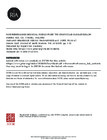Non-mineralised discoidal fossils from the Ordovician Bardahessiagh formation, Co. Tyrone, Ireland
Citation
MacGabhann, B.A., Murray, J. (2010) 'Non-mineralised discoidal fossils from the Ordovician Bardahessiagh formation, Co. Tyrone, Ireland.' Irish Journal of Earth Sciences 28. pp. 1-12. DOI: 10.3318/IJES.2010.28.1.

View/
Date
2010Author
MacGabhann, Breandán Anraoi
Murray, John
Peer Reviewed
YesMetadata
Show full item record
MacGabhann, B.A., Murray, J. (2010) 'Non-mineralised discoidal fossils from the Ordovician Bardahessiagh formation, Co. Tyrone, Ireland.' Irish Journal of Earth Sciences 28. pp. 1-12. DOI: 10.3318/IJES.2010.28.1.
Abstract
Four non-mineralised fossils from the Ordovician Bardahessiagh Formation, near Pomeroy, Co. Tyrone, have been examined for the first time following their recovery from a temporary trench dug in 1992, and are here described as Seputus pomeroii gen. et sp. nov. These are discoidal impressions with up to 120 radial ridges extending from a central ring to a sharply defined margin, and they are tentatively interpreted as rotadiscid eldonids. The fossils are preserved as moulds and casts in a medium-grained quartzose sandstone bed, which is densely packed with corals, trilobites, brachiopods and delicately preserved echinoderms, probably representing an event bed on an outer shelf or upper slope setting. The non-mineralised fossils are likely to represent a para autochthonous assemblage of benthic organisms, preserved by early diagenic mineralisation in anaerobic conditions produced by the decay of organic matter entrained within the bed, a mode of preservation broadly similar to that of non-mineralised fossils from the Ediacaran System. The preserved discs are believed to represent a tough exterior more resistant to decay than the (unknown) remainder of the organism.
Keywords
Non-mineralisedDiscoidal
Fossils
Ordovician Bardahessiagh formation
Co. Tyrone
Ireland

